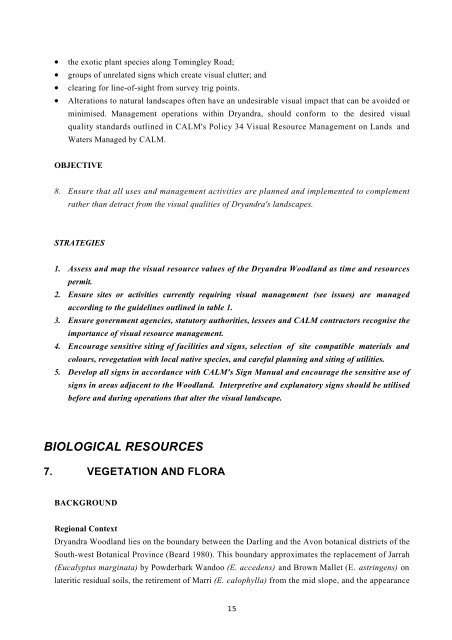Dryandra Woodland - Department of Environment and Conservation ...
Dryandra Woodland - Department of Environment and Conservation ...
Dryandra Woodland - Department of Environment and Conservation ...
Create successful ePaper yourself
Turn your PDF publications into a flip-book with our unique Google optimized e-Paper software.
• the exotic plant species along Tomingley Road;<br />
• groups <strong>of</strong> unrelated signs which create visual clutter; <strong>and</strong><br />
• clearing for line-<strong>of</strong>-sight from survey trig points.<br />
• Alterations to natural l<strong>and</strong>scapes <strong>of</strong>ten have an undesirable visual impact that can be avoided or<br />
minimised. Management operations within <strong>Dry<strong>and</strong>ra</strong>, should conform to the desired visual<br />
quality st<strong>and</strong>ards outlined in CALM's Policy 34 Visual Resource Management on L<strong>and</strong>s <strong>and</strong><br />
Waters Managed by CALM.<br />
OBJECTIVE<br />
8. Ensure that all uses <strong>and</strong> management activities are planned <strong>and</strong> implemented to complement<br />
rather than detract from the visual qualities <strong>of</strong> <strong>Dry<strong>and</strong>ra</strong>'s l<strong>and</strong>scapes.<br />
STRATEGIES<br />
1. Assess <strong>and</strong> map the visual resource values <strong>of</strong> the <strong>Dry<strong>and</strong>ra</strong> <strong>Woodl<strong>and</strong></strong> as time <strong>and</strong> resources<br />
permit.<br />
2. Ensure sites or activities currently requiring visual management (see issues) are managed<br />
according to the guidelines outlined in table 1.<br />
3. Ensure government agencies, statutory authorities, lessees <strong>and</strong> CALM contractors recognise the<br />
importance <strong>of</strong> visual resource management.<br />
4. Encourage sensitive siting <strong>of</strong> facilities <strong>and</strong> signs, selection <strong>of</strong> site compatible materials <strong>and</strong><br />
colours, revegetation with local native species, <strong>and</strong> careful planning <strong>and</strong> siting <strong>of</strong> utilities.<br />
5. Develop all signs in accordance with CALM's Sign Manual <strong>and</strong> encourage the sensitive use <strong>of</strong><br />
signs in areas adjacent to the <strong>Woodl<strong>and</strong></strong>. Interpretive <strong>and</strong> explanatory signs should be utilised<br />
before <strong>and</strong> during operations that alter the visual l<strong>and</strong>scape.<br />
BIOLOGICAL RESOURCES<br />
7. VEGETATION AND FLORA<br />
BACKGROUND<br />
Regional Context<br />
<strong>Dry<strong>and</strong>ra</strong> <strong>Woodl<strong>and</strong></strong> lies on the boundary between the Darling <strong>and</strong> the Avon botanical districts <strong>of</strong> the<br />
South-west Botanical Province (Beard 1980). This boundary approximates the replacement <strong>of</strong> Jarrah<br />
(Eucalyptus marginata) by Powderbark W<strong>and</strong>oo (E. accedens) <strong>and</strong> Brown Mallet (E. astringens) on<br />
lateritic residual soils, the retirement <strong>of</strong> Marri (E. calophylla) from the mid slope, <strong>and</strong> the appearance<br />
15

















